They May Crush the Flowers...
With Vera Chytilová's satirical feminist romp Daisies released on DVD this year, Iain Boal takes the opportunity to revisit the brief cultural explosion that was the Czech New Wave and one of its most original and irreverent contributions
The production of souls is more important than the production of tanks ... And therefore I raise my glass to you, cultural workers, the engineers of the human soul.
- Joseph Stalin, speaking at the home of Maxim Gorky, 26 October 1932
The socialist state nationalised film and gave the film-makers much better potential opportunities than other regimes ... They did not have to seek financial backing for their intentions, or struggle to subsist - as employees of the studios they received a permanent salary. Even the tedious arguments between the directors of the New Wave and Novotny's bureaucracy were in a sense more dignified than the quarrels of the same directors with some of their Western profit-oriented patrons.
- Josef Škvorecký, All the Bright Young Men and Women: A Personal History of the Czech Cinema, 1971, p.249
Among the enduring memories of late '68 for me: the smell of frightened horses in Grosvenor Square, the sound of the Missa Luba sung by the Congolese boys' choir in Lindsay Anderson's If...., and the opening scene of Daisies - two flesh-and-blood dolls embarking on a ludic orgy of low-tech destruction and sexual havoc, framed by pilot's eye footage of terror from the air which is mirrored in the final moments of the film by a collapsing chandelier that detonates an atomic explosion.
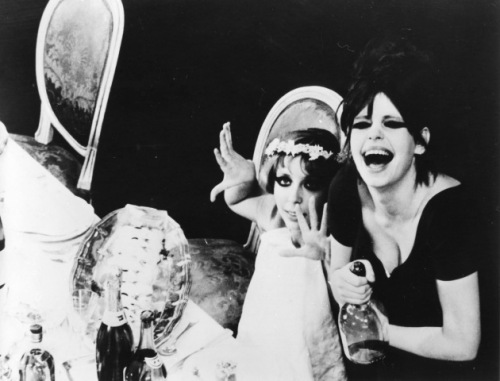
All images: stills from Vera Chytilová's Daisies, 1966
Vera Chytilová's Daisies was originally released on 30 December 1966. It carried off the Grand Prix at the Bergamo Festival and was immediately banned from cinemas in Czechoslovakia. The fellow directors of the Czech New Wave assembled in defense of Chytilová, the only woman among them. The group photograph of Miloš Forman, Jiri Menzel, Jan Nemec, Evald Schorm, Vera Chytilová, Jaromil Jireš, Ivan Passer, Pavel Jurácek, Hynek Bocan, and Antonín Máša marked their single collective act, after Daisies had been charged with formalism and being insufficiently narrative.
Kudos to the folks at Second Run DVD for issuing a re-mastered, digital transfer of Daisies (Sedmikrásky). They are also to be commended for folding into the package Journey (Cesta), Jasmina Blaževic's documentary about Chytilová's life as a film-maker, which informs - indeed, transforms - one's viewing of Daisies. Chytilová, who was born in Ostrava, Czechoslovakia in 1929, headed at a young age for Brno, where she studied philosophy and architecture: ‘I moved to the city, to avoid living with imbeciles.' Certain things she was not able to leave behind: ‘I am from a Catholic family. I left that basic, personified faith - it seemed like a crutch to me, I realised it wasn't true - but those moral codes are inside me.'
She was drawn into film by way of jobs in the world of 2D representation as a draughtswoman and photographic retoucher. Her film career began characteristically; she recalls her interview at the Film and TV School of the Academy of Performing Arts (FAMU) in Prague: ‘I knew something was wrong, because they were directors all of them sitting there, and I said I wanted to study because I didn't like their films. I didn't like their predictability ... they were so boring, simply.'
FAMU had been established in 1946 when the Czech cinema industry was nationalised at the end of the war. The importance of FAMU and the milieu of the Barrandov Studios for Chytilová and her generation of filmmakers is attested by Miloš Forman who recalled ‘a sense of freedom, hundreds of films, and the character and stature of the people you have around to talk them over with - I guess those are about the most important things anybody can give you.'i
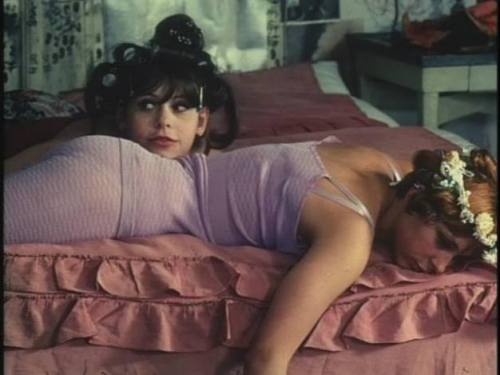
Forman's ‘sense of freedom' was all the more acute for knowing very well its limits. For Chytilová, the trouble she had getting into the academy was just the beginning. She was threatened with ejection from film school for using Louis Armstrong's ‘Up in the Morning' on a sound track. On the dangers of jazz the Czech Communist Party apparently saw eye to eye with the Nazis, whose embargo on ‘Negroid and Negrito Factors in dance Music and Music for Entertainments' prohibited the use of ‘tonally undefined mordents, ostentatious trills, double-stopping or ascendant glissandi, obtained in the Negro style by excessive vibrato, lip technique and/or shaking of the musical instrument.' Also forbidden was ‘substituting senseless syllables for the words in the text' or ‘the use of very primitive instruments such as the Cuban Negro "quijada" (jaw of a donkey), the North American Negro "washboard", and the use of rubber mutes (plungers) for wind brass instruments.'
What then gave Forman and company their ‘sense of freedom'? Considering, that is, the various kinds of censorship which dogged Chytilová's career up to 1989, at which point, ironically, she had to face the dictatorship of the market - in her view, a worse enemy; ‘I knew my enemy was a dangerous idiot, maybe things haven't changed.' First of all, film censorship in Czechoslovakia, and under the Soviet empire generally, was a complicated matter. The communist state often shelved films (Jan Nemec's 1966 absurdist Report on the Party and the Guests was ‘banned forever') after having funded them to completion, a phenomenon not uncommon in Hollywood, but for quite different reasons. This contradiction was mainly due to the semi-autonomous standing of the five production groups at the national film studios at Barrandov, who developed methods of evading direct surveillance. Moreover, there was a history of official encouragement of experimentation as well as conformity, harking back to Lunacharsky's remark in 1928 as People's Commissar for Enlightenment that ‘boring agitation is counter-agitation'.
Josef Škvorecký has described the basic deal under state socialism, and the openings created for the engineers of the human soul inside the ideological apparatus:
The Maecenas State, or rather its cultural bureaucracy, expected in return from its artists a mass production of adult fairy-tales ... [Then] the ranks of government story-tellers and bureaucratic managers are slowly infiltrated by artists and their friends. It might even reach the point when the artists take over the leading positions in the arts altogether, which is what happened, or almost happened, in Czechoslovakia.ii
Such was the situation that permitted the flowering of the Czech New Wave between 1963 and the arrival of the Soviet tanks in Prague in August 1968. But a deeper cultural heritage shaped Chytilová, Passer, Forman and their cohort who worked at the Barrandov studios. Czech cinema had grown out of the avant-garde ‘Devetsil' movement, devoted to revolution in art, life and politics. Several of the New Wave films were based on the work of Devetsil writers. The two leading members of the movement were Jiri Voskovec and Jan Werich, who had produced their first play at the Osvobozené divadlo (Liberated Theatre) in 1927. Škvorecký writes of them: ‘Together with Jaroslav Ježek, the father of Czech jazz, they moulded Dadaism, circus, jazz, Chaplin, Buster Keaton and American vaudeville, into a new art form. They created a new form of intellectual-political musical.'iii
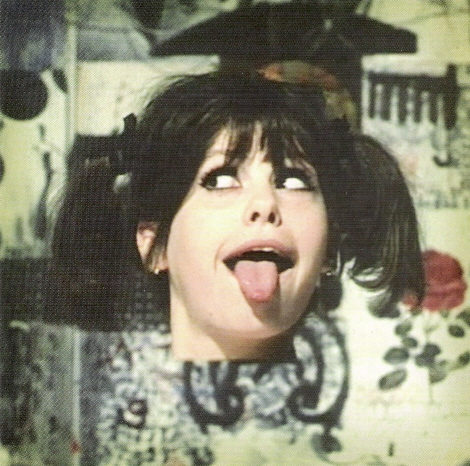
The theatre arts that flourished in Prague gave the set and costume designer, Ester Krumbachová, an entrée to the film studios, and she teamed up with Chytilová to develop a film on the subject of ‘Czech youth'. It took just six months to get permission to start production. They were joined by the cameraman Jaroslav Kucera, who had already departed from orthodoxy with his work in Desire and Diamonds of the Night. They embarked on Daisies in the wake of a period of glasnost and de-Stalinisation in Czechoslovakia, which had led to the official rehabilitation of Kafka, local productions of Ionesco, Beckett and Albee, and the recent release of Louis Malle's Viva Maria!
The script and the brilliant costuming were both the work of Krumbachová. The trio - writer, director and cinematographer - were all, in their own distinctive ways, formalists at heart. The accusation of formalism (never mind ‘insufficient narrative') levelled by the cultural commissars who censored Daisies after the invasion, would have been received as a badge of honour in other circumstances, coming from a different panel of judges. They were indeed guilty as charged; all make dazzling use of the formal means at hand - the new colour film stock to signify the sudden falling from a monochromatic patriarchal world into a vivid Eden of female self-expression, the polyrhythmic intercutting and montage of incidental, improvised mayhem in domestic and public spaces, the startling mix of low, vertical, and Dutch angle shots, the sly surrealism of the costumes and sets. Chytilová has described Daisies as a ‘philosophical documentary in the form of a farce.'iv A farce structured as an existential game of who-gives-a-shit? Vadi? Nevadi! (‘Does it matter?', ‘It doesn't matter'). Hardly surprising, then, that one communist bureaucrat classified the film as a ‘nihilist vehicle'. In Daisies Czech youth frolics under the sign of apocalypse, in a world gone to hell, in a century of war and barbarism.
The credits appear over close-ups of a flywheel and rotating cranks of some heavy industrial machinery doing who know what work out of camera shot. Free association might suggest forces of production, factory quotas, alienation, Chaplin's modern times. It is a hallmark of Chytilová's style, as a director who declines to pull the audience by the nose and who tolerates ambiguity to say the least, that the machine reappears, in long shot, during an escapade in the countryside. It turns out to be gently pumping water onto the smallholding of an old man quietly tending his crops; far from an image of Stalinist productivism, it is an organic part of the pastoral scene.
Daisies proceeds by way of a series of chaotic episodes in the life of a pair of young city girls, whom we first meet bored and sunbathing by a swimming pool. Their robotic movements suggest a couple of mechanical dolls as they creak into action. They describe themelves as ‘panna', a Czech word meaning both ‘doll' and ‘virgin', a pun which gets lost in the subtitles. The dolls decide on some games of their own, dressing themselves up for a revenge of the mannequins, self-willed playthings who embark on a grande bouffe of reverse exploitation. Their victims, in this feminist Menippean satire for the Soviet era, are pasty-faced nomenklatura and ludicrous, hapless suitors, abandoned at the wrong end of food-for-sex exchanges.
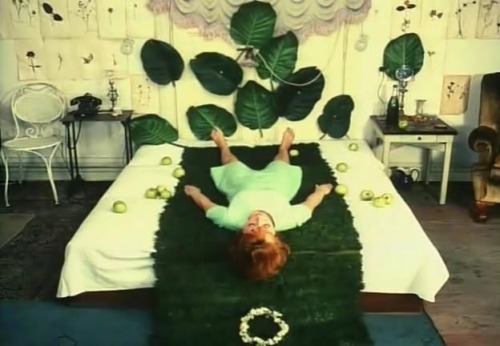
Marie 1 and Marie 11 cut a swathe of destruction through public and domestic spaces: restaurants, a cabaret, the train station, a public toilet, their own apartment, and in the final scene, an empty banquet hall, where their habit of mutilating fruit and vegetables reaches new heights (up on the chandelier). Whispered contrition from the two panna as they try, absurdly, to re-set the smashed crockery and sweep up the mess, did not impress a deputy of the National Assembly who censured the filmmaker for wasting food at a time when farmers were struggling ‘to overcome the problems of agricultural production.' Chytilová's response was to dedicate Daisies to ‘all those whose sole source of indignation is a trampled-on trifle'.
In 1969 the head of the Barrandov studios was arrested and the five production groups disbanded. Miloš Forman and Ivan Passer went immediately into exile, followed soon enough by Nemec, along with 200,000 other Czechs. The majority of the Barrandov crew, however, including Chytilová, chose to stay. She remained under contract with the studios, though in reality, she says in Journey, ‘I was banned from making films...' In a 1975 open letter addressed to ‘Dear Comrade President Husák', Chytilová describes the Kafkaesque predicament of having her contract terminated on the grounds that she had done no work for five years. In addition to which the ‘complex assessment' committee laid out a bill of indictment, that
my films were experimental by nature, uncommitted and pessimistic, that I had contacts with people connected with National Artists Jiri Trnka and Jan Werich, that my international prizes came chiefly from western festivals, that I had presided at the Mannheim Festival, had adopted an elitist stance, that I had had a minimum of audience response, that my films had been overvalued by the critics, and that it ‘did not appear' that I had ‘understood the contemporary cultural policy of the Communist Party of Czechoslovakia'.v
In the face of ostracism by the studios, recalls Chytilová in Journey, ‘I started making commercials. But because I couldn't work under my name, I was shooting using my husband's name, Kucera ... until the clients got fed up with my experiments. I was playing with the material, letting the sound stutter and so on. So they fired me.'
--*--
Last fall in San Francisco, at a Retort salon on the cinema of the Sixties, the film historian and critic David Thomson introduced the evening with this reflection:
The 60s was a decade in which film madness was born again in a series of new waves. Film studies marched through American academia. All over the world, the dream of political films was encouraged by thoughts of an international audience. And so Bonnie and Clyde began as a picture for Truffaut or Godard, and directors from Czechoslovakia, Poland, Hungary and Yugoslavia began to test the ice of censorship and control. All of a sudden, film seemed to be the universal language of critical thinking and outraged liberties. Old empires wavered in the breeze as pretty kids on the screen robbed banks, executed the school authorities (If....), and suggested that the greatest crack in tyranny's wall came where sexual energy was working the hardest (Deep End, Taking Off, WR - Mysteries of the Organism). Happy Days, and wistful the age that has to look back.
The Soviet empire is no more, Czechoslovakia no longer exists, and the remarkable generation of film-makers who worked at the old Barrandov Studios in Prague is now passing. Ivan Passer, looking back, said: ‘It looked like one day everything would be possible. At the time, we had no idea that this period would last only ... six, seven years, which is an extremely short period of time for any art and especially for film because it usually takes three years to get a story idea up on the screen.'vi
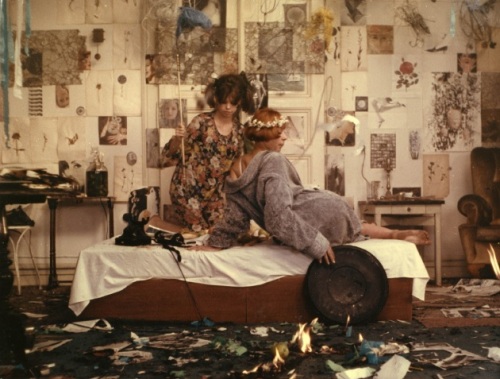
Blaževic's documentary reveals Chytilová's stubborn, unquenchable desire to keep making films, and includes a self-mocking description of the ruses (‘tactical hysteria' among them) developed in a world of male power, Stalinist and otherwide. Writing in Cineaste after the collapse of the Soviet regime Barbara Quart concluded: ‘Vera Chytilova has survived everything ... Although she (with Jiri Menzel) led the fight against privatisation of the film industry, her new film Happiness is All Well (1992) had substantial private backing ... [The film] direct[s] mockery at every level of the current sociopolitical situation.'vii
Towards the end of Journey she has this to say: ‘Only what you do, in the short time given to you, is real.' I find it hard not to take this poignant verdict as a specific reference to that brief springtime - a moment seized as much as given - when in the company of Krumbachová, Kucera and the cohort at Barrandov, Vera Chytilová helped to spark a world-historical detonation in which we imagined more than daisy-crowned dolls swinging from the chandeliers.
Iain Boal <retort AT sonic.net> is a social historian of science and technics, associated with Retort. He is author of the forthcoming book The Long Theft: Episodes in the History of Enclosure
Info
Daisies (Sedmikrásky), 1966, directed by Vera Chytilová; screenplay by Ester Krumbachová and Vera Chytilová; art and costume design by Ester Krumbachová; cinematography by Jaroslav Kucera.
Journey (Cesta): A Portrait of Vera Chytilová, 2004, written and directed by Jasmina Blazevic; camera Stepan Kucera; produced by Katerina Cerna.
Remastered and released by Second Run DVD, 2009. www.secondrundvd.com
Editor's Note
Due to an issue with the website, some Czech characters have been Anglicised, e.g. 'Vera Chytilová' is properly spelt with a hácek over the 'e'. In fact, 'hácek' has an unreadable accent over its 'c'. Our technicians are working around the clock to solve this problem.
Footnotes
i Peter Hames, The Czechoslovak New Wave, 2nd ed., London: Wallflower Press, 2005, p.28.
ii Josef Škvorecký, All the Bright Young Men and Women, Toronto: Peter Martin, with Take One magazine, 1971, pp. 249-50.
iii Ibid., pp.23-4.
iv Hames, op. cit., p.187.
v Index on Censorship, Vol. 5, #2, 1976.
vi Robert Buchar, Czech New Wave Filmmakers in Interviews, North Carolina: McFarland & Co, Jefferson, 2003, p.83.
viiBarbara Quart, ‘Three Central European women directors revisited’, Cineaste, vol.19, #4,1993, pp.58-61.
Mute Books Orders
For Mute Books distribution contact Anagram Books
contact@anagrambooks.com
For online purchases visit anagrambooks.com






